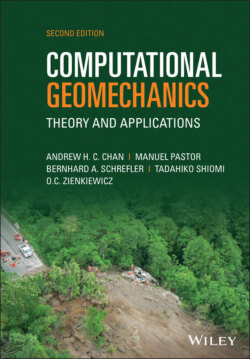Читать книгу Computational Geomechanics - Manuel Pastor - Страница 2
Table of Contents
Оглавление1 Cover
2 Title Page Theory and Applications
3 Copyright Page
4 Preface
5 1 Introduction and the Concept of Effective Stress 1.1 Preliminary Remarks 1.2 The Nature of Soils and Other Porous Media: Why a Full Deformation Analysis Is the Only Viable Approach for Prediction 1.3 Concepts of Effective Stress in Saturated or Partially Saturated Media Note References
6 2 Equations Governing the Dynamic, Soil–Pore Fluid, Interaction 2.1 General Remarks on the Presentation 2.2 Fully Saturated Behavior with a Single Pore Fluid (Water) 2.3 Partially Saturated Behavior with Air Pressure Neglected (p a = 0) 2.4 Partially Saturated Behavior with Air Flow Considered (p a ≥ 0) 2.5 Alternative Derivation of the Governing Equation (of Sections 2.2–2.4) Based on the Hybrid Mixture Theory 2.6 Conclusion References
7 3 Finite Element Discretization and Solution of the Governing Equations 3.1 The Procedure of Discretization by the Finite Element Method 3.2 u‐p Discretization for a General Geomechanics’ Finite Element Code 3.3 Theory: Tensorial Form of the Equations 3.4 Conclusions References
8 4 Constitutive Relations 4.1 Introduction 4.2 The General Framework of Plasticity 4.3 Critical State Models 4.4 Generalized Plasticity Modeling 4.5 Alternative Advanced Models 4.6 Conclusion References
9 5 Special Aspects of Analysis and Formulation 5.1 Introduction 5.2 Far‐Field Solutions in Quasi‐Static Problems1 5.3 Input for Earthquake Analysis and Radiation Boundary 5.4 Adaptive Refinement for Improved Accuracy and the Capture of Localized Phenomena 5.5 Stabilization of Computation for Nearly Incompressible Behavior with Mixed Interpolation6 5.6 Conclusion Notes References
10 6 Examples for Static, Consolidation, and Hydraulic Fracturing Problems 6.1 Introduction 6.2 Static Problems 6.3 Seepage1 6.4 Consolidation2 6.5 Hydraulic Fracturing: Fracture in a Fully Saturated Porous Medium Driven By Increase in Pore Fluid Pressure3 6.6 Conclusion References
11 7 Validation of Prediction by Centrifuge 7.1 Introduction 7.2 Scaling Laws of Centrifuge Modelling 7.3 Centrifuge Test of a Dyke Similar to a Prototype Retaining Dyke in Venezuela 7.4 The Velacs Project 7.5 Comparison with the Velacs Centrifuge Experiment 7.6 Centrifuge Test of a Retaining Wall (Dewooklar et al 2009) 7.7 Conclusions References
12 8 Applications to Unsaturated Problems 8.1 Introduction 8.2 Isothermal Drainage of Water from a Vertical Column of Sand 8.3 Air Storage Modeling in an Aquifer 8.4 Comparison of Consolidation and Dynamic Results Between Small Strain and Finite Deformation Formulation 8.5 Dynamic Analysis with a Full Two‐Phase Flow Solution of a Partially Saturated Soil Column Subjected to a Step Load 8.6 Compaction and Land Subsidence Analysis Related to the Exploitation of Gas Reservoirs1 8.7 Initiation of Landslide in Partially Saturated Soil2 8.8 Conclusion References
13 9 Prediction Application and Back Analysis to Earthquake Engineering 9.1 Introduction 9.2 Material Properties of Soil 9.3 Characteristics of Equivalent Linear Method 9.4 Port Island Liquefaction Assessment Using the Cycle‐Wise Equivalent Linear Method (Shiomi et al. 2008) 9.5 Port Island Liquefaction Using One‐Column Nonlinear Analysis in Multi‐Direction 9.6 Simulation of Liquefaction Behavior During Niigata Earthquake to Illustrate the Effect of Initial (Shear) Stress 9.7 Large‐Scale Liquefaction Experiment Using Three‐Dimensional Nonlinear Analysis 9.8 Lower San Fernando Dam Failure References
14 10 Beyond Failure: Modeling of Fluidized Geomaterials 10.1 Introduction 10.2 Mathematical Model: A Hierarchical Set of Models for the Coupled Behavior of Fluidized Geomaterials 10.3 Behavior of Fluidized Soils: Rheological Modeling Alternatives 10.4 Numerical Modeling: 2‐Phase Depth‐Integrated Coupled Models 10.5 Examples and Applications 10.6 Conclusion References
15 Index
16 End User License Agreement
